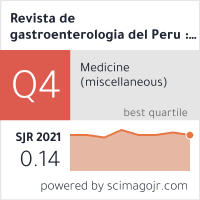Colorectal cancer in the young: clinicopathologic features and prognostic factors from a cancer institute in Peru
DOI:
https://doi.org/10.47892/rgp.2016.361.21Palabras clave:
Colorectal neoplasms, Survival, Prognosis, Young adult, PeruResumen
Objective: To determine clinicopathological features and prognostic factors among young colorectal cancer (CRC) patients in a Peruvian Cancer Institute. Methods: Data of patients 40 years or younger, admitted between January 2005 and December 2010, were analyzed. Results: During the study period, 196 young patients with CRC were admitted. The tumor was located in the rectum, left colon and right colon in 45.9%, 28.6% and 25.5% of cases. Family history of CRC was found in 13.2% and an autosomal pattern of inheritance, in 8.6% of the cases. The most common symptoms were pain (67.9%) and bleeding (67.3%). The majority (63.1%) of colon cancer cases and more than a third (34.4%) of rectal cancer cases were diagnosed in stage III or IV. The histologic type was tubular, mucinous and signet ring cell adenocarcinoma in 73.5%, 14.8% and 8.6%, respectively. The depth of invasion was T3 in 21.4% and T4 in 53%. Nodal involvement was detected in 44.5%. Five-year overall survival (OS) was 44.3%. In the multivariate analysis, only the stage resulted an independent prognostic factor for survival. Conclusions: CRC in Peruvian young patients is mostly sporadic. It presents more often in the distal colon or rectum and at advanced stages of the disease. Mucinous and signet ring cell carcinoma were frequent histological types. Five-year OS stage by stage is similar to that reported in the literature for older patients. Stage was the only independent prognostic factor for survival.Descargas
Los datos de descargas todavía no están disponibles.
Métricas
Cargando métricas ...
Descargas
Publicado
17.07.2016
Cómo citar
1.
Ruiz R, Taxa L, Ruiz EF, Mantilla R, Casanova L, Montenegro P. Colorectal cancer in the young: clinicopathologic features and prognostic factors from a cancer institute in Peru. Rev Gastroenterol Peru [nternet]. 17 de julio de 2016 [citado 18 de diciembre de 2025];36(1):35-42. isponible en: https://revistagastroperu.com/index.php/rgp/article/view/21
Número
Sección
ARTÍCULOS ORIGINALES
Licencia
Revista de Gastroenterología del Perú by Sociedad Peruana de Gastroenterología del Perú is licensed under a Licencia Creative Commons Atribución 4.0 Internacional..
Aquellos autores/as que tengan publicaciones con esta revista, aceptan los términos siguientes:
- Los autores/as conservarán sus derechos de autor y garantizarán a la revista el derecho de primera publicación de su obra, el cuál estará simultáneamente sujeto a la Licencia de reconocimiento de Creative Commons que permite a terceros compartir la obra siempre que se indique su autor y su primera publicación esta revista.
- Los autores/as podrán adoptar otros acuerdos de licencia no exclusiva de distribución de la versión de la obra publicada (p. ej.: depositarla en un archivo telemático institucional o publicarla en un volumen monográfico) siempre que se indique la publicación inicial en esta revista.
- Se permite y recomienda a los autores/as difundir su obra a través de Internet (p. ej.: en archivos telemáticos institucionales o en su página web) antes y durante el proceso de envío, lo cual puede producir intercambios interesantes y aumentar las citas de la obra publicada. (Véase El efecto del acceso abierto).
















 2022
2022 